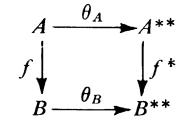For any homomorphism f : A - B of left R-modules the diagram is commutative, where
Question:
For any homomorphism f : A - B of left R-modules the diagram  is commutative, where θA,θB are as in Theorem 4.12 and ∫* is the map induced on A** = HomR(HomR(A,R),R) by the map ∫̅: HomR(B,R) - HomR(A,R).
is commutative, where θA,θB are as in Theorem 4.12 and ∫* is the map induced on A** = HomR(HomR(A,R),R) by the map ∫̅: HomR(B,R) - HomR(A,R).
Data from theorem 4.12
Let A be a left module over a ring R.
(i) There is an R-module homomorphism θ: A→A**.
(ii) i∫ R has an identity and A is free, then θ is a monomorphism.
(iii) i∫ R has an identity and A is free with a finite basis, then θ is an isomorphism. A module A such that θ: A → A** is an isomorphism is said to be reflexive.
PROOF OF 4.12.
(i) For each a ϵ A let θ(a): A* → R be the map defined by [θ(a)](∫) = (a,∫) ϵ R. Statement (2) after Theorem 4.10 shows that θ(a) is a homomorphism of right R-modules (that is, θ(a) ϵ A**). The map θ: A → A** given by a|→ θ(a) is a left R-module homomorphism by (1) after Theorem 4.10.
(ii) Let X be a basis of A. If a ϵ A, then a = r1x1 + r2x2 + · · · + rnxn (ri ϵ R; Xi ϵ X). If θ(a) = 0, then for all ∫ ϵ A*,  In particular, for ∫= ∫xj (j = 1,2, ... , n),
In particular, for ∫= ∫xj (j = 1,2, ... , n),  Therefore,
Therefore, ![]() and θ is a monomorphism.
and θ is a monomorphism.
(iii) If X is a finite basis of A, then A* is free on the (finite) dual basis {∫x Ix ϵ X} by Theorem 4.11. Similarly A** is free on the (finite) dual basis {gx Ix ϵ X}, where for each x ϵ X, gx: A* → R is the homomorphism that is uniquely determined by the condition: gx(∫y) = δxy (y ϵ X). But θ(x) ϵ A** is a homomorphism A* → R such that for every y ϵ X ![]() Hence gx = θ(x) and {θ(x) Ix ϵ X} is a basis of A**. This implies that Im θ = A**, whence θ is an epimorphism.
Hence gx = θ(x) and {θ(x) Ix ϵ X} is a basis of A**. This implies that Im θ = A**, whence θ is an epimorphism.
Step by Step Answer:

Algebra Graduate Texts In Mathematics 73
ISBN: 9780387905181
8th Edition
Authors: Thomas W. Hungerford





